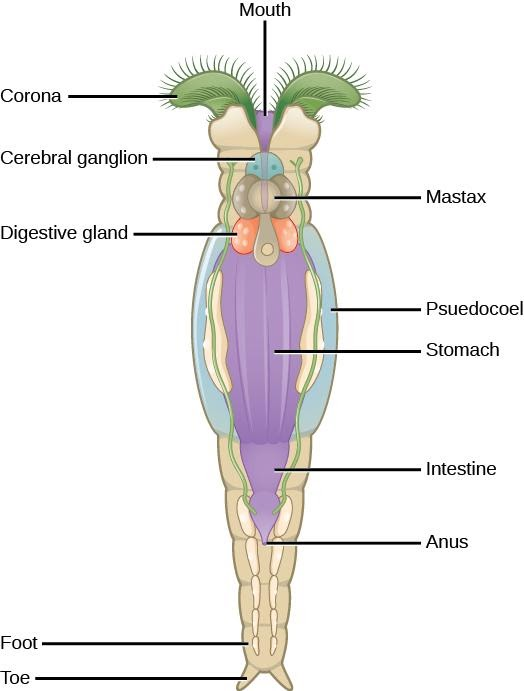
What are Rotifers?
Answer
394.8k+ views
Hint: Rotifers belong to phylum Rotifera and are also called wheel animals. The smallest phylum in all is Rotifera which include minute aquatic animals which are multicellular in nature which have wheel-like ciliated organ use for swimming and feeding. They were first described by Rev. John Harris in 1696. Later Antonie Van Leeuwenhoek described other forms of rotifers in 1703.
Complete answer:
Rotifers are generally found in freshwater called pseudocoelomates and sometimes found in saltwater too. The word rotifer comes from the Neo-latin word which means “Wheel bearer”. The labelled diagram of Rotifer is shown below:

The corona is present around the mouth whose motion is similar to a wheel. That's why rotifers' names are wheel animals. The length of rotifers lies between 0.1 mm to 0.5 mm but some rotifers range from 50µm to 2 mm. Around 2200 rotifers species have been discovered and having a three subclasses –
1. Seisonidea: They have very little in common. They consist of only 2 known genera with 3 species of each. The mode of reproduction is sexual.
2. Bdelloidea: 350 species of this group are to be known. It can be reproduced by the process of parthenogenesis.
3. Monogononta: This is the largest group in three with about 1500 species to be known and existence. The mode of reproduction is asexual.
They are bilaterally symmetrical animals and have different types of shapes. Their body is divided in three parts – head, trunk and foot. They have a coronal cilia which helps to sweep the food in the mouth of these species.
Note:
Rotifers do not have a circulatory system, the exchange of gases takes place by the help of the body surface. Male rotifers have a non-functional digestive system; by this they have a short life span.
Due to the nature of rotifers that are nutrient recycling they are used to clean the water in the fish tanks and prevent the clouds formation of waste matter.
Complete answer:
Rotifers are generally found in freshwater called pseudocoelomates and sometimes found in saltwater too. The word rotifer comes from the Neo-latin word which means “Wheel bearer”. The labelled diagram of Rotifer is shown below:

The corona is present around the mouth whose motion is similar to a wheel. That's why rotifers' names are wheel animals. The length of rotifers lies between 0.1 mm to 0.5 mm but some rotifers range from 50µm to 2 mm. Around 2200 rotifers species have been discovered and having a three subclasses –
1. Seisonidea: They have very little in common. They consist of only 2 known genera with 3 species of each. The mode of reproduction is sexual.
2. Bdelloidea: 350 species of this group are to be known. It can be reproduced by the process of parthenogenesis.
3. Monogononta: This is the largest group in three with about 1500 species to be known and existence. The mode of reproduction is asexual.
They are bilaterally symmetrical animals and have different types of shapes. Their body is divided in three parts – head, trunk and foot. They have a coronal cilia which helps to sweep the food in the mouth of these species.
Note:
Rotifers do not have a circulatory system, the exchange of gases takes place by the help of the body surface. Male rotifers have a non-functional digestive system; by this they have a short life span.
Due to the nature of rotifers that are nutrient recycling they are used to clean the water in the fish tanks and prevent the clouds formation of waste matter.
Latest Vedantu courses for you
Grade 10 | MAHARASHTRABOARD | SCHOOL | English
Vedantu 10 Maharashtra Pro Lite (2025-26)
School Full course for MAHARASHTRABOARD students
₹33,300 per year
Recently Updated Pages
Master Class 9 General Knowledge: Engaging Questions & Answers for Success

Master Class 9 English: Engaging Questions & Answers for Success

Master Class 9 Science: Engaging Questions & Answers for Success

Master Class 9 Social Science: Engaging Questions & Answers for Success

Master Class 9 Maths: Engaging Questions & Answers for Success

Class 9 Question and Answer - Your Ultimate Solutions Guide

Trending doubts
State and prove Bernoullis theorem class 11 physics CBSE

Who built the Grand Trunk Road AChandragupta Maurya class 11 social science CBSE

1 ton equals to A 100 kg B 1000 kg C 10 kg D 10000 class 11 physics CBSE

State the laws of reflection of light

One Metric ton is equal to kg A 10000 B 1000 C 100 class 11 physics CBSE

Difference Between Prokaryotic Cells and Eukaryotic Cells




